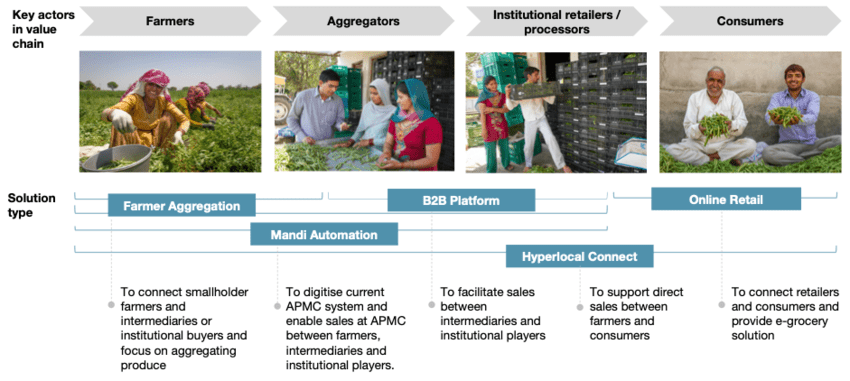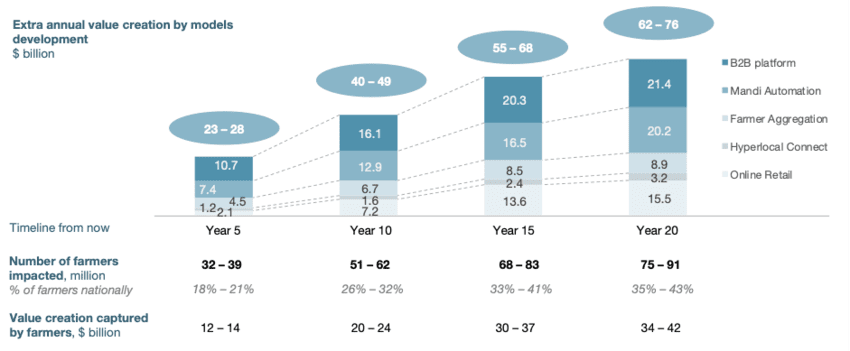Agri-Tech Innovation Can Improve Value Capture, Transform Ecosystem for India’s Small Farmers
Learn how agri-technology can improve the livelihoods of smallholder farmers by creating cost efficiencies, introducing transparency in information flows, and strengthening the connectivity between value chain actors.
Editor’s Note: This article was originally published by the World Economic Forum.
- Smallholders account for 86% of farmers in India but are economically impoverished, as they are unable to capture commensurate value for their produce.
- Technology offers huge potential to improve farmer incomes by driving overall value creation and increasing value captured by farmers.
- Integrated ecosystem solutions can improve value creation and capture at farmgate, potentially adding $76 billion annually to the ecosystem, most of which goes to farmers.
- B2B buyer-supplier matching platforms and Mandi Automation show greatest potential, given ability to improve coordination between multiple supply and demand centers.
Agriculture is a critical pillar of the Indian economy, engaging 43% of the national employed workforce. However, smallholders – those owning less than 2 hectares of land, compared with 2-10 ha for medium holders and more than 10 ha for large holders – who account for 86% of all farmers in India, are still some of the poorest people in the country, earning only 39% of what medium holders earn, and only 13% of what large holders earn.
Typically, smallholder farmers are unable to capture commensurate value for their produce due to low visibility of demand, exploitative intermediation, limited quality assurance, limited access to efficient and low-cost logistics, and low bargaining power.
To improve farmer incomes, it is necessary to improve their value capture and to drive overall value creation in the agricultural ecosystem. Technology offers the potential to develop and iterate solutions rapidly, create cost efficiencies, introduce transparency in information flows, and strengthen connectivity between value chain actors.
Given the critical role that agriculture plays in the Indian economy and the persistently economically disadvantaged position of farmers in the country, there is a need to address challenges in the farmgate-to-fork (F2F) ecosystem and make agriculture more remunerative for farmers.
What are the Opportunities for Solutions?
Four essential levers can drive value capture and value creation:
- Direct matching between farmers and buyers
- Transparent quality assessment
- Cost-efficient and timely transportation
- Aggregation of small-volume produce
Numerous high-potential technologies have emerged in India to address these solutions, some demonstrating proof of concept. India is strongly positioned to take these technologies to scale. An internet user base of 560 million users (50% located in rural areas), high smartphone penetration, and an AI market valued at $6.4 billion (16% of the global AI market) reflect India’s rapidly evolving agricultural technology landscape comprising of innovators, investors, and adopters who can develop, test, and adopt solutions at scale.
Subscribe to our newsletter to learn more about how TechnoServe leverages technology to help smallholder farmers in the developing world increase their incomes and improve their lives.
5 Tech Solutions Identified for F2F Ecosystem
We have identified five types of technology solutions that can create value in F2F as highlighted below. Among these, B2B buyer-supplier matching platforms and Mandi Automation are expected to be the game-changers that could drive the majority of value creation.
1. B2B buyer-supplier matching platforms would facilitate linkages between aggregators and institutional buyers and processors. These platforms would service a wide range of crops and provide exhaustive information on the quality, quantity, and price of produce to facilitate buyer-supplier matching. While different B2B platforms already exist in the market, they have significant gaps in the functionalities they offer. At a mature state, a fully functional B2B platform could create an extra annual value of $19-24 billion, allowing farmers to capture most of this value.
2. Mandi Automation solution would digitalize the traditional retail channel, i.e. the Agricultural Produce Market Committees (APMCs), and connect smallholder farmers to intermediaries and institutional buyers. The National Agriculture Market (eNAM), a government-led technology initiative in Mandi Automation, presently handles less than 1% of commodity trading volumes and accounts for less than 0.1% of the total trading value in the APMC channel. To scale up, eNAM must take onboard more farmers and buyers by extending more incentives and by optimizing functionalities. At a mature state, eNAM could potentially create an extra annual value of $18-22 billion.
3. Farmer aggregation solution would facilitate the aggregation of produce from smallholder farmers and connect farmers with aggregators and institutional buyers.
4. Hyperlocal connect solution would help farmers sell their fresh produce directly to local consumers.
5. Online retail solution would facilitate sales between retailers and consumers, and focus on delivering user-friendly e-grocery options.
Eventually, we expect that the five technology solutions would add significant value to the ecosystem (approximately $62-76 billion on an annual basis), with farmers to capture $34–42 billion (50-60%) of this value. It is expected that 75–91 million farmers would benefit from the value creation associated with these solutions over a 20-year timeframe, accounting for 35-43% of the farmers in India. With the extra value capture, income from crop cultivation among the farmers impacted would increase by 70-80% over the 20-year term.
How to Bring the Identified Tech Solutions Forward
To accelerate the development of these solutions, immediate actions and collaboration from different actors are required:
– Big Tech and agri-tech players must cooperate closely on developing technology solutions. Big Tech companies must commit to building best-in-class B2B buyer-supplier matching platforms, taking learnings from the e-commerce industry. Big Tech would also support emerging agri-tech players providing solutions in quality assurance, traceability, etc., by enhancing their solutions through AI, machine learning, etc.
– Agricultural businesses must support emerging technology platforms by adopting them on a large scale.
– Government support is essential for the development of solutions. The Ministry of Agriculture would need to invest in enhancing the capabilities and adoption of eNAM in consultation with NGOs, agribusinesses, and tech companies. Additionally, state governments could take the lead to facilitate on-ground implementation of pilots to accelerate learning and improvement.
– Donors and investors would need to provide sustained funding for the pilot and scale-up of integrated platforms in different commodities and markets.
– Agricultural and social organizations could help implement the solution in both pilot and scale-up phases, leveraging the participation of farmers and Farmer Producer Organisations (FPOs), to accelerate testing and deployment of projects.
Meaningful Change
As next steps, stakeholders from different domains need to develop a shared vision and commit to long-term support to transform the F2F ecosystem with technology interventions. Key actors must invest in integrating best practices and best-in-class technologies into these solutions, in rapid piloting and scale-up of ideas, in coordination among value chain actors, and in sustained funding support to ensure long-term success.
We encourage and invite more stakeholders to join us in building impactful and viable solutions for the F2F ecosystem, and we look forward to working together to create meaningful change by harnessing the power of technology.

